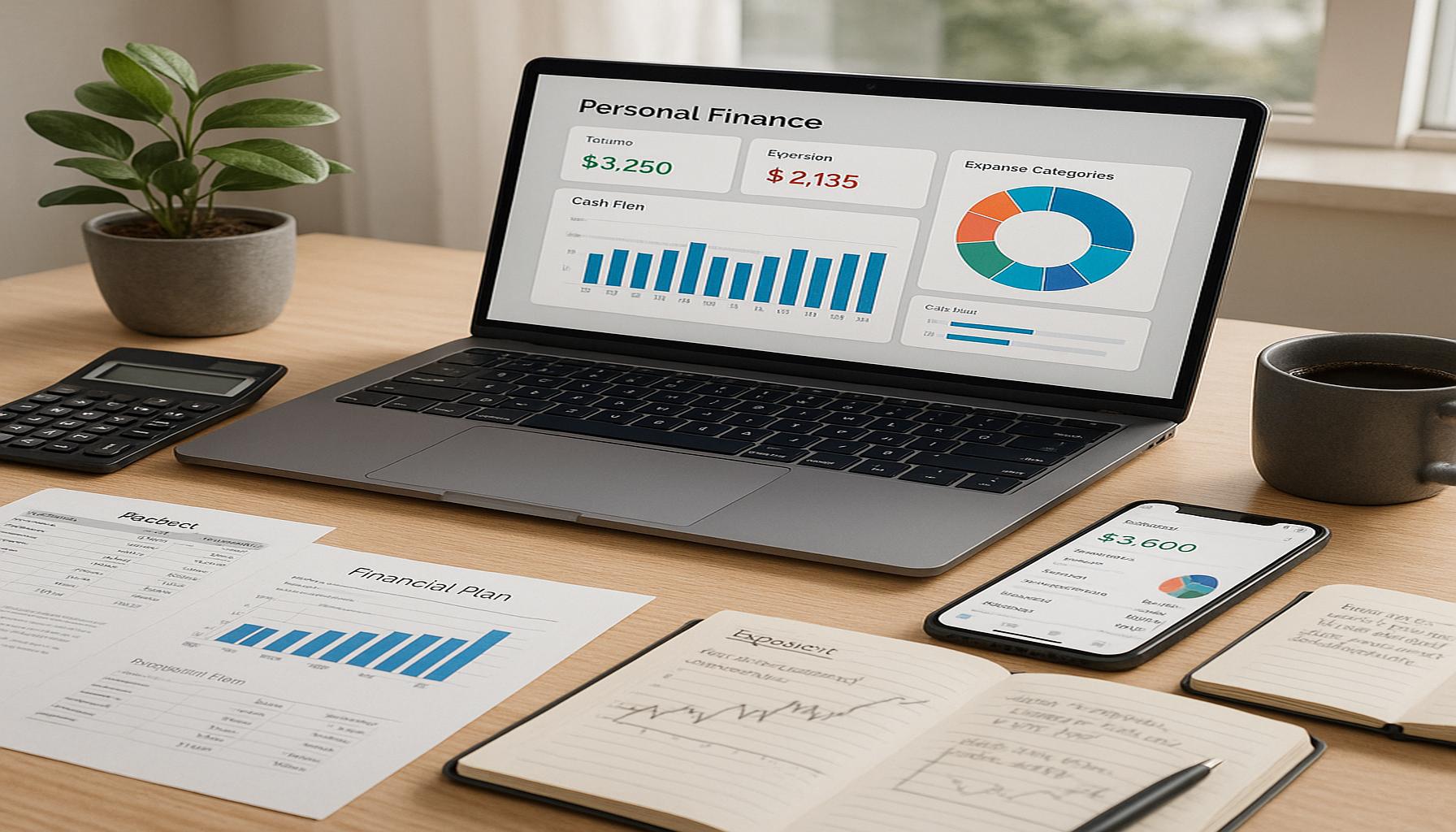How to Use Technology to Manage Your Personal Finances Efficiently

Transforming Financial Management Through Technology
In today’s digital age, technology has transformed the way we handle our personal finances. With countless tools and applications at our fingertips, keeping track of expenses, budgeting, and saving has never been easier. Whether you are a seasoned financial planner or just starting to manage your money, leveraging technology can lead to improved financial health and smarter financial decisions.
Benefits of Using Technology
By embracing financial technology, you can:
- Gain real-time insights: Keeping tabs on your financial status has become incredibly easy. Mobile banking apps provide instant updates, allowing you to track your spending and monitor account balances without the need for spreadsheets or ledger books. For instance, you can get alerts when your bank balance drops below a certain amount, helping you avoid overdraft fees.
- Automate your budgeting: Many budgeting apps, such as Mint or YNAB (You Need A Budget), allow you to set up budgets that adjust automatically based on your spending habits. With YNAB, for example, you can allocate funds for different categories like groceries, entertainment, and savings, and the app automatically adjusts your budget if you overspend in one area.
- Access expert advice: Just as we turn to professionals for medical or legal help, financial apps can provide tailored financial advice and assistance. Some platforms even offer insights based on your spending patterns, pointing out opportunities for savings or investments that you might have overlooked.
Many Canadians have begun utilizing technology for their financial needs. For example, apps like Wealthsimple make investing accessible for everyone, even if you have limited knowledge. Users can start with as little as $1 and benefit from a diversified portfolio managed by professionals.
Additionally, online banking platforms often offer mobile apps with features like bill payments, direct deposits, e-transfers, and spending trackers. These functionalities enable you to handle transactions quickly and manage your gifts, everyday shoppings, and monthly bills all in one place. For instance, with Interac e-Transfers, Canadians can send money to friends and family instantly, making it convenient to settle shared expenses or gifts.
Understanding and applying these tools can lead to greater financial success and stability. As we delve deeper into the various technological tools and practices available today, you will find that finances don’t have to be a daunting task. With the right tools, managing your money can become a streamlined and efficient process at your convenience.
Essential Tools for Financial Management
To effectively manage your personal finances using technology, it’s important to understand the various tools and applications available to you. Each tool serves a unique purpose and can help simplify different aspects of your financial life. Below are some key categories of technological tools that can enhance your financial management:
1. Budgeting Applications
Budgeting can be daunting, but with the right applications, it becomes much more manageable. Apps like Mint and YNAB (You Need A Budget) are excellent resources for setting and maintaining a budget. These apps allow you to:
- Link your bank accounts: By connecting your bank account directly to these apps, your transactions are automatically imported, giving you a clear picture of your spending habits without manual entry.
- Set financial goals: Whether it’s saving for a vacation or paying off debt, these apps can help you establish and track your goals, providing motivation to stay on course.
- Visualize your spending: Graphs and charts show how much you spend in each category, allowing you to pinpoint areas where you can cut back and save more money.
2. Investment Platforms
Investing can feel intimidating, especially if you’re just getting started. However, platforms like Wealthsimple make investing accessible for everyone. With these services, you can:
- Diversify your portfolio: Even with a small amount of money, these platforms offer the option to invest in a variety of assets, minimizing risk while still allowing for potential growth.
- Utilize robo-advisors: Many investment platforms utilize algorithms to manage your investments for you. This means you don’t need to be an expert; the platform does the work based on your risk tolerance and objectives.
- Automate contributions: Regular contributions to your investment account can compound over time. Many platforms allow you to set automatic transfers from your bank account to ensure you continually invest without the need for manual transactions.
3. Expense Trackers
Another vital aspect of managing your personal finances is tracking your daily expenses. Financial apps such as PocketGuard and Wally can assist in this regard. These apps enable you to:
- Record your expenses easily: With just a few taps, you can log purchases, ensuring you stay within your budget.
- Identify patterns: Expense trackers can show you where you might be overspending on certain items, such as dining out or entertainment, allowing you to make informed adjustments.
- Review your spending habits: By reviewing your monthly spending summary, you can see trends over time, helping you make adjustments and improve your financial wellbeing.
Incorporating these tools into your financial routine can greatly enhance your capability to manage your finances. By understanding how each application operates and utilizing its features, you can establish a comprehensive overview of your financial landscape. This knowledge enables you to make better financial decisions, ultimately leading to improved financial stability and growth.
Leveraging Financial Technology for Informed Decision-Making
In addition to essential tools for budgeting, investing, and tracking expenses, there are other significant technologies that can aid you in making informed financial decisions. Understanding how to leverage these resources can help you further refine your financial management skills and achieve better outcomes for your financial health.
1. Financial Planning Software
Comprehensive financial planning software can provide deeper insights into your overall financial situation. Programs like Quicken and eMoney Advisor offer robust features that enable you to:
- Create detailed financial plans: These tools can assist in creating a well-structured financial plan that encompasses your income, expenses, investments, and retirement savings goals.
- Simulate future financial scenarios: By inputting different variables, you can see how changes in income or spending might affect your future financial situation, empowering you to make more strategic decisions.
- Access professional advice: Some software options provide access to financial advisors, allowing for tailored advice based on your unique situation and goals.
2. Online Banking Services
Modern online banking has transformed the way Canadians manage their finances. Most major banks offer user-friendly apps and online portals that enable you to:
- Make transactions quickly: Transferring money, paying bills, and setting up direct deposits can all be done seamlessly through banking apps. For example, using your bank’s mobile app, you can easily transfer funds to your savings account or pay your credit card bill from the comfort of your home.
- Monitor your account activity: Real-time notifications and alerts keep you informed about your account balance and transactions, which can help you avoid overdraft fees and spot unauthorized activities swiftly.
- Manage multiple accounts efficiently: You can view and manage various accounts — from checking to savings and even investment accounts — all in one place, streamlining your financial oversight.
3. Tax Preparation Software
Tax season can be overwhelming, but technology has simplified the process significantly. Programs like TurboTax and H&R Block make it easier to file your taxes by:
- Automating calculations: These tools help ensure accuracy by automatically calculating deductions and credits, minimizing the risk of errors.
- Providing step-by-step guidance: User-friendly interfaces guide you through the tax preparation process, helping you understand each step and ensuring you don’t miss out on potential savings.
- Maximizing refunds: Tax software often includes tools that help you identify eligible deductions that you might not have known about, potentially increasing your tax refund.
4. Financial Education Resources
Educating yourself is a crucial component of effective financial management. Many organizations and websites offer free or low-cost webinars, articles, and courses focused on personal finance. Resources such as Coursera or edX provide the opportunity to learn about financial literacy, investment strategies, and more, helping you:
- Stay updated on financial trends: Understanding market changes and financial regulations helps you make informed decisions regarding your investments and savings.
- Enhance your budgeting skills: By learning new techniques, you can develop better budgeting skills that may significantly improve your financial stability.
- Network with experts: Engaging in community discussions and webinars allows you to connect with financial experts and like-minded individuals, offering a platform for support and learning.
The effective use of technology in these aspects of personal finance not only empowers individuals to gain control over their financial landscape but also fosters a proactive approach to managing their finances. By leveraging these advanced tools, you can create a more solid financial future with greater confidence and clarity.
Conclusion
In today’s digital age, effectively managing your personal finances requires an embrace of technology. Various tools and resources have made it easier than ever to gain a comprehensive understanding of your financial landscape, from budgeting to tax preparation. By utilizing financial planning software, you can craft detailed financial strategies that adapt to your changing needs, while online banking services allow for hassle-free transactions and real-time monitoring of your accounts. Furthermore, tax preparation software simplifies the filing process, ensuring you maximize deductions and refunds with ease.
Education remains a cornerstone of sound financial management. By engaging with financial education resources, you can continuously enhance your knowledge, ensuring that you remain informed about market shifts and how they affect your financial choices. Just as important is the ability to connect with community experts through online platforms and webinars, which can offer valuable insights that you might have otherwise overlooked.
Ultimately, using technology to manage your personal finances not only provides convenience but also enables you to make informed decisions that have the potential to improve your overall financial health. As you integrate these tools into your daily routine, you pave the way for a more organized, confident approach to your finances. By prioritizing financial literacy and leveraging the power of technology, you are better equipped to navigate your financial journey—leading to long-term stability and prosperity.
Related posts:
How to Use Personal Finance Apps to Manage Your Budget in Canada
The psychology of money: how your beliefs influence your personal finances
How to Deal with Debt: Strategies for Financial Reorganization
Investing in ETFs: An Introduction for Beginners in the Canadian Market
How to Deal with Unexpected Costs: Financial Strategies for Emergency Situations in Canada
Differences Between Private Pension and Other Types of Investment

James Carter is a financial writer and advisor with expertise in economics, personal finance, and investment strategies. With years of experience helping individuals and businesses make complex financial decisions, James offers practical insight and analysis. His goal is to give readers the knowledge they need to achieve financial success.